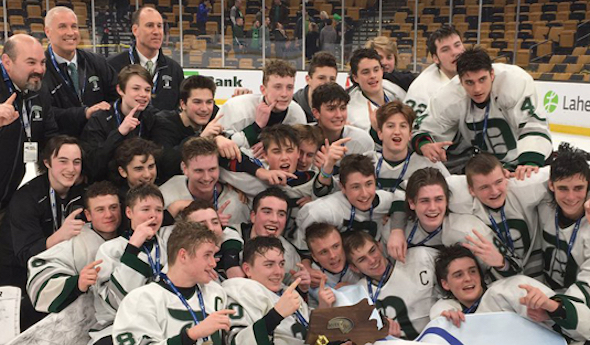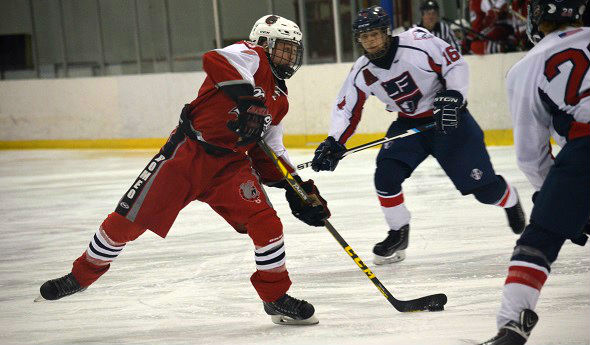
Title Time Differs Among Hockey States
July 12, 2019
By Rob Kaminski
MHSAA benchmarks editor
Next season’s three-week playoff format for the MHSAA Ice Hockey Tournament will fall more closely in line with similar postseasons for state associations around the country which sponsor the sport.
According to 2017-18 National Federation of State High School Associations participation statistics, 18 states sponsor boys ice hockey.
Michigan ranked third in number of schools involved with 240, behind Minnesota (282) and Massachusetts (278). In terms of overall participants, the MHSAA was fourth with 3,353, trailing Massachusetts (7,377), Minnesota (5,751) and New Jersey (3,492) and just ahead of New York (3,088). Wisconsin and Ohio boast more than 2,000 participants annually.
So, how do the tournaments compare among those states similar to Michigan? Most use longer tournament calendars than the two-week span previously employed by the MHSAA.
The timeframe for the season just past in the Minnesota tournament had most play beginning Feb. 21 and ending the same day as the MHSAA Finals, March 9. Some teams started on Feb. 19. The MHSAA dropped the puck for its first games on Monday, Feb. 25. It should be noted that Minnesota crowns just two champions annually, compared to the MHSAA’s three divisions.
Meanwhile, in Wisconsin and Ohio, just one school takes the statewide title each year, so it stands to reason that the postseason is spread out even further. Both states began the 2019 playoffs on Monday, Feb. 11.
Wisconsin’s tourney culminated on March 2 at Veteran’s Memorial Coliseum in Madison as teams played the Quarterfinals, Semifinals and Final over three consecutive days.
Ohio, meanwhile, took a week-long break following District Finals on March 1 or 2, then played the Semifinals and Final at Nationwide Arena in Columbus during March 8-9. This is similar to the rest period the MHSAA will enjoy moving forward from its Quarterfinals to the Semifinals and Finals in 2020.
Just as the season was reaching its pinnacle in Wisconsin, the postseason title chase was merely beginning in Massachusetts, where this year it opened Feb. 25.
Massachusetts is tied for the most divisions of the states studied here with four, but the top division is created with a different twist.
“The top division is often called the ‘Super 8’ or 1A. This tournament is set up differently than the other divisions,” said Massachusetts Ice Hockey Coaches Association President Dan Connolly. “The Super 8 is a double-elimination tournament. The seedlings for this tournament are done by power seeding via a committee using strength of schedule, record, team vs. teams under consideration and win-loss record down the stretch.”
Connolly said just 10 teams are chosen for the Super 8, and seed Nos. 7 through 10 must face off in a play-in game to join the top six. The two teams losing the play-in game return to their respective pre-assigned state divisions and can still win those tournaments. Such was the case in 2019, when Duxbury High lost in its bid to join the Super 8 field, but then won the Division 1 Final.
Like Michigan, those three divisions are based on enrollment, but unlike Michigan, the divisions are seeded based on winning percentage.
The Finals take place on a Sunday at the TD Garden in Boston, a celebration of hockey that features six games (four boys and two girls finals). This year’s event took place March 17, and nearly went into March 18. The Division 1 Final began at 9:59 p.m. as the previous contest, the Super 8 Final, went to four overtimes.
As mentioned, Minnesota’s tournament ended the same day as the MHSAA’s in 2019, and featured one overtime game among its two Finals at the Xcel Energy Center in St. Paul as Edina took the top class over Eden Prairie, 3-2.
The Sunday finales in Boston might seem foreign to followers of MHSAA tournaments, but New York also features a Sunday as the stage for its two state Finals, following Semifinals on Saturday. This year’s playoffs went from Feb. 20-March 10, culminating at the Harborcenter in Buffalo.
Neighboring New Jersey comes closest in length to the old MHSAA format with four divisions – three public and one non-public – taking just 14 days to determine winners at the Prudential Center in Newark. The 2019 titles were determined on Monday, March 4, with Semifinals the Wednesday prior.
PHOTO: Duxbury celebrated Massachusetts’ Division 1 championship this past season after missing out on making the “Super 8” bracket.

Romeo Icers' Goal: Make More History
By
Tom Markowski
Special for Second Half
January 15, 2016
ROMEO – It’s often been said that if a school has a successful football season, that excitement generated in the fall will carry over to the other athletic programs.
 Although Romeo hockey coach Nick Badder doesn’t have any football players who were a part of the school’s Division 1 championship win in November, he’s hoping that success will breed success on the ice.
Although Romeo hockey coach Nick Badder doesn’t have any football players who were a part of the school’s Division 1 championship win in November, he’s hoping that success will breed success on the ice.
Romeo defeated Detroit Cass Tech, 41-27, at Ford Field to capture the school’s first football MHSAA title. And the hockey team is off to the best start in school history, as the Bulldogs are 12-0 and the team to beat in the Macomb Area Conference Red.
When asked if there is indeed a carryover effect, Badder initially discounted it – and then reassessed the significance.
“I wouldn’t say so,” he said at first. “It was cool for the guys to go down there (to Ford Field) and win.
“That’s our goal. It was a motivator in the beginning. It was good for (our players) to see. The school spirit was lifted, and we want to get there, too. We want the same thing.”
Should Romeo win the Division 2 hockey title this March, it would be the first time a Macomb County program won an MHSAA title in hockey since Fraser won Class A in 1983.
It’s been a steady rise for this program. Romeo lost to Warren DeLaSalle, 3-2, in a Regional Final in 2014, and last season the Bulldogs reached the Quarterfinals for the first time before losing to Grosse Pointe South, 8-2.
Badder, 26, was an assistant in the program in 2014 and took over as head coach last season.
 He said the loss to South was an important lesson to learn, for him and his players.
He said the loss to South was an important lesson to learn, for him and his players.
“We didn’t have big-game experience,” he said. “We didn’t handle the situation well. That’s what we’ve been trying to do this year. We don’t want those 9-5 type of games.”
The first order of business was to tighten up the defense. The fact that Badder returned both goaltenders from last season was a good starting point. Junior Nolan Kare has a .883 save percentage and has started every game. Sophomore Grant Williams is his backup.
Kare is not your typical goalie. He’s not afraid to speak his mind whether it’s on the ice or in the locker room.
“He really gets into the game,” Badder said. “He’s a hard worker and a great kid.”
The biggest improvement from last season’s team to this one is depth. Romeo’s first line returns intact, and center Nick Blankenburg is the catalyst. The team captain, Blankenburg doesn’t get outworked. Highly skilled and packing plenty of power despite his smaller size (5-foot-7, 140 pounds), Blankenburg sets the tone and has 19 goals and nine assists.
“Everyone on the team respects him,” Badder said. “And he’s got a bomb for a shot.”
Fellow senior Logan Jenuwine plays left wing and, just like last season, is the team’s top point-getter. He had 90 last season and has 18 goals and 20 assists in 12 games this winter.
At right wing is junior Brett Lanski. He trails only his line mates in points with seven goals and 14 assists.
 Romeo’s objective it to jump the other team quickly, grab an early lead and let its depth wear down the opposition.
Romeo’s objective it to jump the other team quickly, grab an early lead and let its depth wear down the opposition.
“That’s what we do,” Badder said. “They’re a high-flying line. We put them together late last January, and they’ve had a lot of success. We tried something different to start (this) season, but we went back to those three and that’s where they’ll stay.”
Badder lost seven seniors to graduation but said the juniors, who bring travel-team experience, have filled the gaps.
“They all can play,” Badder said. “There isn’t a guy out there who doesn’t belong. If we had an injury (last season) it would have been crippling. Not this year. Even the top guys have nights off. Someone has to pick up the slack.”
Shoring up the defense has been seniors Steven Morris and Logan Ganfield. Badder said these defensemen are his most improved players.
Parts of that strong junior class are center Jake Petry and winger Frank Ruffino.
The breakthrough the team experienced last season, capturing a Regional title, set the groundwork for this winter. Winning breeds confidence, and the Bulldogs are riding that wave.
“Our practices have been tight,” Badder said. “There’s no fooling around.
“I learned a lot last year. Everything I’ve done are the things I would want when I played.”
 Tom Markowski is a columnist and directs website coverage for the State Champs! Sports Network. He previously covered primarily high school sports for the The Detroit News from 1984-2014, focusing on the Detroit area and contributing to statewide coverage of football and basketball. Contact him at [email protected] with story ideas for Oakland, Macomb and Wayne counties.
Tom Markowski is a columnist and directs website coverage for the State Champs! Sports Network. He previously covered primarily high school sports for the The Detroit News from 1984-2014, focusing on the Detroit area and contributing to statewide coverage of football and basketball. Contact him at [email protected] with story ideas for Oakland, Macomb and Wayne counties.
PHOTOS: (Top) Romeo's Zach Peters looks for an opening against Livonia Franklin. (Middle) Romeo coach Nick Badder, center Nick Blankenburg and goaltender Nolan Kare. (Below) Blankenburg (26), Jake Petri (24), Steven Morris (36) and Kare stand strong as part of a solid defense. (Photos courtesy of Donna Peters.)

